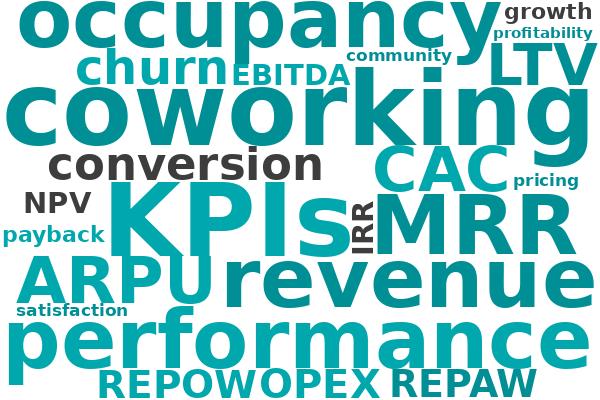Measuring the performance of a coworking space goes far beyond tracking occupancy rates or monthly revenue. In a competitive and ever-evolving market, operators who make data-driven decisions have a clear advantage. To achieve this, it is essential to have a solid system of KPIs (Key Performance Indicators) that provide insight into the health of the business and guide strategic planning.
Thanks to management tools like Nexudus, OfficeRnD, or Cobot, most of this data is already collected automatically. However, the real challenge lies in interpreting it correctly to make informed decisions, identify opportunities for improvement, and create sustainable growth projections.
Below are the most important coworking KPIs that every operator should track regularly.
1. Occupancy Rate (%)
- Measures: The percentage of space being used compared to the total available.
- Formula: (Occupied workstations / Total workstations) × 100
- Target: >85%
- Importance: Evaluates operational efficiency and helps detect underutilized capacity or positioning issues.
2. Monthly Recurring Revenue (MRR)
- Measures: Recurring income from active memberships.
- Formula: Monthly sum of recurring revenues
- Target: Stable growth
- Importance: Provides financial visibility and facilitates planning.
3. ARPU (Average Revenue per User)
- Measures: Average revenue per member.
- Formula: Monthly income / Number of members
- Target: Maximize through additional services
- Importance: Highlights opportunities to increase the average ticket.
4. CAC (Customer Acquisition Cost)
- Measures: The cost of acquiring a new client.
- Formula: Marketing and sales expenses / New clients
- Target: Keep it < LTV
- Importance: Key for evaluating the ROI of acquisition strategies.
5. LTV (Customer Lifetime Value)
- Measures: Total value contributed by a client over their membership.
- Formula: ARPU × Average duration (months)
- Target: >3× CAC
- Importance: Determines long-term return on acquisition investment.
6. Churn Rate
- Measures: Percentage of clients leaving over a period.
- Formula: (Clients lost / Initial clients) × 100
- Target: <5% monthly
- Importance: Reflects retention, satisfaction, and community strength.
7. Lead Conversion Rate
- Measures: Commercial efficiency.
- Formula: (Converted leads / Total leads) × 100
- Target: >25%
- Importance: Indicates the effectiveness of sales and marketing actions.
8. Meeting Room Usage (%)
- Measures: Utilization of shared spaces.
- Formula: (Hours used / Total available hours) × 100
- Target: >50%
- Importance: Helps generate extra revenue and optimize layout.
9. Revenue per Square Meter
- Measures: Profitability per usable square meter.
- Formula: Monthly income / Usable m²
- Target: >€20/m²/month
- Importance: Enables benchmarking between locations and operating costs.
10. Net Promoter Score (NPS)
- Measures: Customer satisfaction and loyalty.
- Formula: % Promoters (9-10) – % Detractors (0-6)
- Target: >40
- Importance: Anticipates organic growth and reflects community health.
11. OPEX per Member
- Measures: Monthly operating cost per user.
- Formula: Operating expenses / Number of members
- Target: <€150/month
- Importance: Essential for sustaining profitability.
12. Net Present Value (NPV)
- Measures: Present value of future cash flows discounted at a rate.
- Formula: Σ(Cash flow / (1 + discount rate)^n) – Initial investment
- Target: Positive
- Importance: Assesses project profitability versus alternative investments.
13. Internal Rate of Return (IRR)
- Measures: Average annual return on investment.
- Formula: Rate at which NPV = 0
- Target: Higher than discount rate
- Importance: Evaluates long-term project performance.
14. Payback Period
- Measures: Time to recover initial investment.
- Formula: When cumulative net profit exceeds initial investment
- Target: In rentals, shorter than contract term; in purchases, less than asset’s useful life
- Importance: Simple risk indicator based on time.
15. EBITDA
- Measures: Earnings before interest, taxes, depreciation, and amortization.
- Formula: Net profit + taxes + interest + amortization
- Target: EBITDA/Revenue > 40% mid-term
- Importance: Represents true operating cash flow.
16. EBITDA Margin
- Measures: EBITDA as a percentage of total revenue.
- Formula: EBITDA / Revenue
- Target: Around 40%
- Importance: Tracks operational efficiency relative to income.
17. Annual Shareholder Return
- Measures: Annual EBITDA in relation to shareholder’s initial investment.
- Formula: EBITDA / Shareholder investment
- Target: Higher than discount rate
- Importance: Reflects annual ROI without terminal value assumptions.
18. Average Collection Period
- Measures: Average time to collect payments from clients.
- Formula: Accounts receivable / (Revenue / 12)
- Target: <2 months (ideally <1)
- Importance: Long periods indicate poor financial management.
19. Average Payment Period
- Measures: Average time to pay suppliers.
- Formula: Accounts payable / (Monthly operating expenses excluding HR)
- Target: <2 months
- Importance: Affects liquidity and supplier relationships.
20. REPOW (Revenue per Occupied Workstation)
- Measures: Monthly income per occupied desk.
- Formula: Total revenue / Occupied desks
- Target: Maximize without sacrificing experience
- Importance: Measures profitability per active unit.
21. REPAW (Revenue per Available Workstation)
- Measures: Monthly income per available desk (occupied or not).
- Formula: Total revenue / Total desks
- Target: Improve occupancy and pricing
- Importance: Evaluates space-wide efficiency.
22. Average Price per Occupied Seat
- Measures: Average amount paid per desk.
- Formula: Membership income / Occupied seats
- Target: Align price with perceived value
- Importance: Supports sustainable pricing strategies.
23. Revenue Growth Rate
- Measures: Growth in revenue over time.
- Formula: (Current revenue – Previous revenue) / Previous revenue × 100
- Target: Steady and scalable growth
- Importance: Indicates business evolution and expansion potential.
Conclusion
These coworking KPIs are powerful tools for any operator aiming to make strategic, data-driven decisions. Monthly tracking allows you to spot bottlenecks, seize opportunities, and adapt your strategy proactively.
At Happy Working Lab, we help you design and implement KPI systems tailored to your space—turning insights into action and data into sustainable growth.
Want to boost your coworking space’s performance? Contact us and let’s get started.
